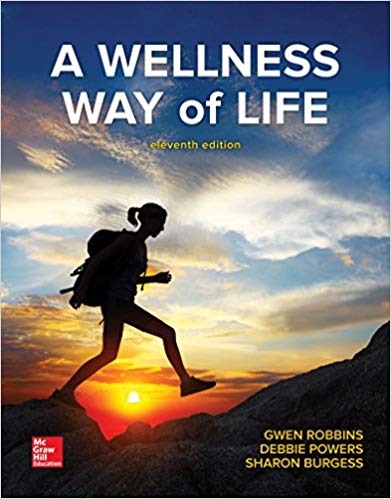Test Bank For A Wellness Way of Life 11th Edition by Gwen Robbins
Original price was: $55.00.$24.00Current price is: $24.00.
Digital item No Waiting Time Instant Download
ISBN-13: 978-0073523507 ISBN-10: 9780073523507
Description
Test Bank For A Wellness Way of Life 11th Edition by Gwen Robbins
Chapter 03 Developing and Assessing Physical Fitness
Multiple Choice Questions
1. Reports indicate that the average American’s weight
A. is increasing.
B. is decreasing.
C. is remaining the same.
D. is similar to Americans fifty years ago.
E. has not been researched.
Accessibility: Keyboard Navigation
Topic: The Importance of Exercise
2. Which of the following is NOT considered a hypokinetic condition?
A. coronary heart disease
B. osteoporosis
C. pneumonia
D. obesity
E. diabetes
Accessibility: Keyboard Navigation
Topic: The Importance of Exercise
3. Findings of several studies show that the physical fitness levels of American youth are
A. increasing.
B. decreasing.
C. remaining the same.
D. similar to their parents.
E. equal to European children.
Accessibility: Keyboard Navigation
Topic: The Importance of Exercise
4. Which of the following statements is TRUE concerning health benefits from physical activity?
A. Physical activity must be in a single session to be beneficial.
B. Include 30 minutes of moderate intensity aerobic exercise 5 days a week for health.
C. Adding daily physical activity impacts health statistics for disease but not for cancer or other health conditions.
D. Adults over age 65 should avoid physical activity.
E. Shopping, mopping, and taking out trash count as moderate physical activity.
Accessibility: Keyboard Navigation
Topic: The Importance of Exercise
5. We know that four behaviors account for 78% of the risk of chronic disease. Which of these can cut risk of premature death in half?
A. not using tobacco
B. eating a healthy diet
C. exercising most days of the week
D. not abusing alcohol
E. All four behaviors must be implemented to cut the risk of premature death in half.
Accessibility: Keyboard Navigation
Topic: The Importance of Exercise
6. Increasing levels of obesity are related to inactivity as the average American now spends more than half of the day
A. sitting.
B. eating.
C. sleeping.
D. online.
E. texting.
Accessibility: Keyboard Navigation
Topic: The Importance of Exercise
7. To attain the health benefits from physical activity, the emphasis should be on exercise of _________ intensity.
A. moderate
B. intense
C. leisurely
D. punishing
E. maximum
Accessibility: Keyboard Navigation
Topic: The Importance of Exercise
8. A minimum of _________ minutes per day of vigorously intense aerobic exercise is recommended for health benefits.
A. 10
B. 20
C. 40
D. 60
E. 90
Accessibility: Keyboard Navigation
Topic: The Importance of Exercise
9. Exercise for Americans over 65 years of age should include aerobic activity, strengthening, flexibility, and
A. agility training.
B. coordination.
C. sport-specific skills.
D. power drills.
E. balance.
Accessibility: Keyboard Navigation
Topic: The Importance of Exercise
10. ACSM recommends a minimum of __________ minutes per day of moderate-intensity exercise for health.
A. 10
B. 15
C. 30
D. 60
E. 90
Accessibility: Keyboard Navigation
Topic: The Importance of Exercise
11. For health-related fitness, the ACSM recommends doing 8-10 strength training exercises _________ days per week.
A. two
B. three
C. four
D. five
E. six
Accessibility: Keyboard Navigation
Topic: The Importance of Exercise
12. In a landmark study of physical fitness and longevity, Dr. Stephen Blair found that the greatest reduction in risk of death occurred between the _________ levels of fitness.
A. low and medium
B. medium and high
C. high and extremely high
Accessibility: Keyboard Navigation
Topic: The Importance of Exercise
13. An example of a vigorous level of moderate of activity is
A. fishing.
B. washing and waxing the car.
C. gardening.
D. dancing fast.
E. washing windows.
Accessibility: Keyboard Navigation
Topic: The Importance of Exercise
14. For balanced fitness, cardiorespiratory exercises should be supplemented with 8-10 __________-developing exercises 2-3 times per week.
A. strength
B. agility
C. speed
D. coordination
E. flexibility
Accessibility: Keyboard Navigation
Topic: The Importance of Exercise
15. A health-related fitness component is
A. flexibility.
B. agility.
C. speed.
D. coordination.
E. All of these are health-related fitness components.
Accessibility: Keyboard Navigation
Topic: The Health-Related Components of Fitness
16. Which of the following fitness components is performance-related?
A. speed
B. power
C. agility
D. reaction time
E. All of these are performance-related fitness components.
Accessibility: Keyboard Navigation
Topic: The Health-Related Components of Fitness
17. The most important health-related component of physical fitness is
A. body composition.
B. cardiorespiratory endurance.
C. muscular strength.
D. muscular endurance.
E. flexibility.
Accessibility: Keyboard Navigation
Topic: The Health-Related Components of Fitness
18. What is the term for the capacity of a muscle to exert a repeated force against resistance?
A. muscular overload
B. muscular endurance
C. muscular strength
D. muscular hypertrophy
E. muscular duration
Accessibility: Keyboard Navigation
Topic: The Health-Related Components of Fitness
19. The key to progressive overload is to increase exercise time by no more than __________ percent per week.
A. 10
B. 15
C. 30
D. 50
E. 60
Accessibility: Keyboard Navigation
Topic: The Principles of Fitness Development
20. The 1.5-mile run test measures
A. muscular strength.
B. muscular endurance.
C. flexibility.
D. cardiorespiratory endurance.
E. body composition.





Be the first to review “Test Bank For A Wellness Way of Life 11th Edition by Gwen Robbins”